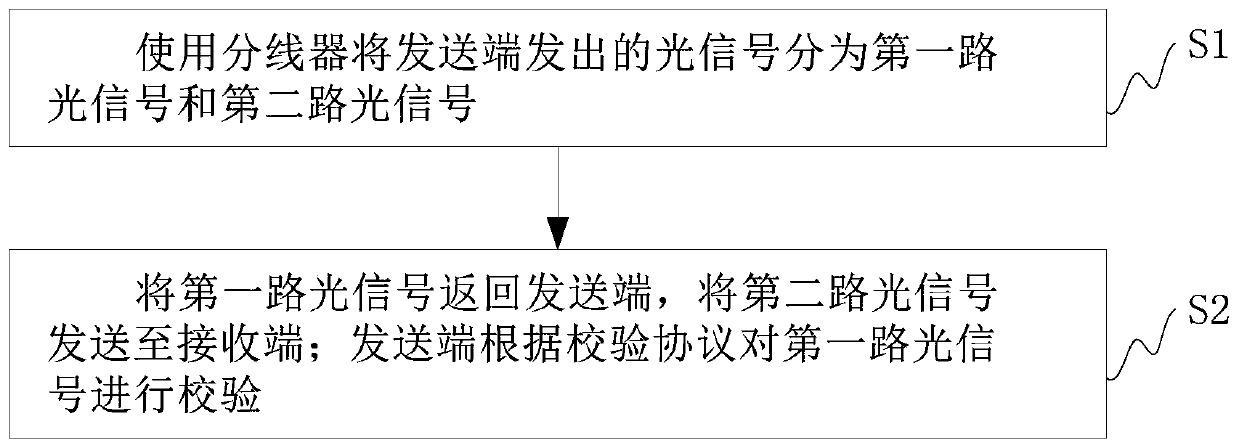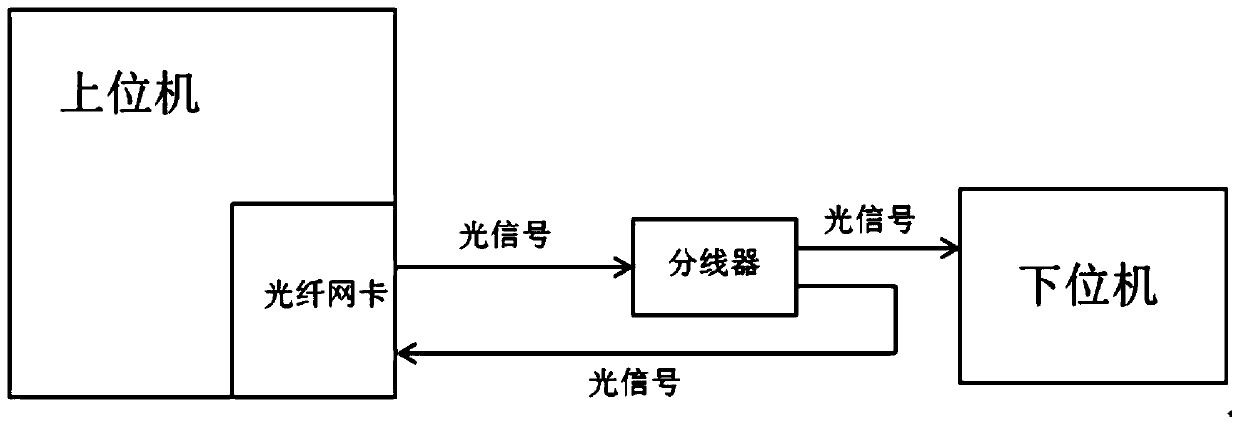Self-checking optical fiber data one-way transmission method and system based on Ethernet
A one-way transmission and self-verification technology, which is applied in the direction of optical fiber transmission, can solve the problems of one-way transmission without verification function, increase the difficulty and cost of lower computer development, achieve enhanced transmission stability and reliability, and improve Transmission speed and network channel utilization, the effect of simplifying hardware composition
- Summary
- Abstract
- Description
- Claims
- Application Information
AI Technical Summary
Problems solved by technology
Method used
Image
Examples
Embodiment approach 1
[0034] This implementation mode provides an Ethernet-based self-checking optical fiber data unidirectional transmission method, such as figure 1 shown, including:
[0035] Step S1: Use a splitter to divide the optical signal sent by the sending end into a first optical signal and a second optical signal.
[0036] Step S2: return the first optical signal to the sending end, and send the second optical signal to the receiving end; the sending end verifies the first optical signal according to the verification protocol.
[0037] The first optical signal and the second optical signal split by the splitter have the same information. The sending end can be a host computer with an optical fiber network card, the receiving end can be a lower computer with an optical module, and the splitter can be a fiber optic splitter. After the second optical signal is sent to the receiving end, the receiving end can convert the second optical signal into an electrical signal and store it in the ...
Embodiment 1
[0041] In this example, the specific transfer process is:
[0042] Step 1: The upper computer sends data through the optical fiber network card, and the optical fiber network card converts the electrical signal into an optical signal through the optical module, and the optical signal is divided into the same two channels through the optical fiber splitter.
[0043] Step 2: All the way is captured by the lower computer and stored in the buffer.
[0044] Step 3: The other way returns to the optical fiber network card, and the host computer program accepts it, and verifies the data according to the verification protocol. If the verification is successful, continue to send, and if the verification fails, resend.
[0045] If the transmitted data does not need to be verified, step 3 can be omitted.
[0046] The remarkable effect of this embodiment is that, using the characteristics of the optical fiber network card having the function of self-sending and self-receiving, the optical...
Embodiment approach 2
[0048] This embodiment provides an Ethernet-based self-checking optical fiber data one-way transmission system, such as figure 2 As shown, it includes the sending end, the splitter and the receiving end; the sending end is used to transmit the optical signal to the splitter; the splitter is used to divide the optical signal from the sending end into the same two paths, and the first path returns to the The sending end, and the sending end checks; the second transmission is to the receiving end.
[0049] The sending end can be a host computer with an optical fiber network card, and the receiving end can be a lower computer with an optical module. The receiving end is also used to convert the second optical signal into an electrical signal and store it in the buffer. The principle of this embodiment is the same as that of Embodiment 1.
PUM
 Login to View More
Login to View More Abstract
Description
Claims
Application Information
 Login to View More
Login to View More - R&D
- Intellectual Property
- Life Sciences
- Materials
- Tech Scout
- Unparalleled Data Quality
- Higher Quality Content
- 60% Fewer Hallucinations
Browse by: Latest US Patents, China's latest patents, Technical Efficacy Thesaurus, Application Domain, Technology Topic, Popular Technical Reports.
© 2025 PatSnap. All rights reserved.Legal|Privacy policy|Modern Slavery Act Transparency Statement|Sitemap|About US| Contact US: help@patsnap.com



